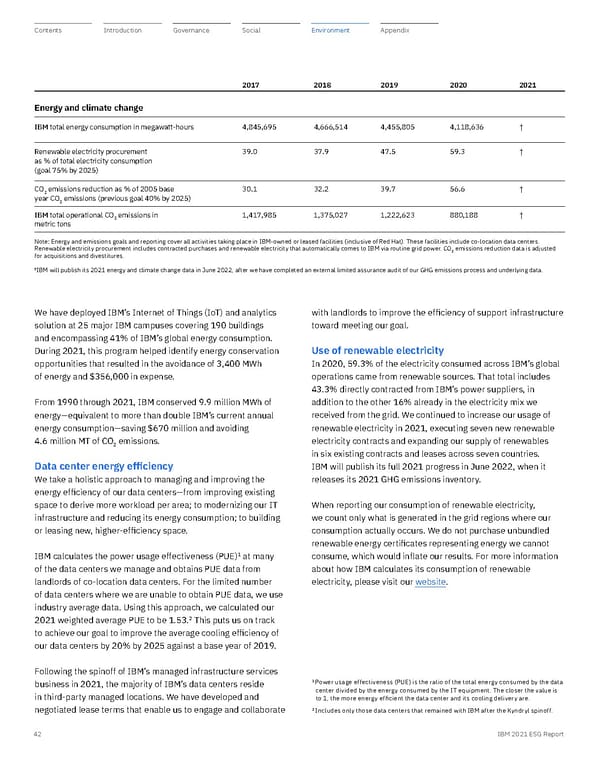We have deployed IBM’s Internet of Things (IoT) and analytics solution at 25 major IBM campuses covering 190 buildings and encompassing 41% of IBM’s global energy consumption. During 2021, this program helped identify energy conservation opportunities that resulted in the avoidance of 3,400 MWh of energy and $356,000 in expense. From 1990 through 2021, IBM conserved 9.9 million MWh of energy—equivalent to more than double IBM’s current annual energy consumption—saving $670 million and avoiding 4.6 million MT of CO 2 emissions. Data center energy efficiency We take a holistic approach to managing and improving the energy efficiency of our data centers—from improving existing space to derive more workload per area; to modernizing our IT infrastructure and reducing its energy consumption; to building or leasing new, higher-efficiency space. IBM calculates the power usage effectiveness (PUE) 1 at many of the data centers we manage and obtains PUE data from landlords of co-location data centers. For the limited number of data centers where we are unable to obtain PUE data, we use industry average data. Using this approach, we calculated our 2021 weighted average PUE to be 1.53. 2 This puts us on track to achieve our goal to improve the average cooling efficiency of our data centers by 20% by 2025 against a base year of 2019. Following the spinoff of IBM’s managed infrastructure services business in 2021, the majority of IBM’s data centers reside in third-party managed locations. We have developed and negotiated lease terms that enable us to engage and collaborate 1 Power usage effectiveness (PUE) is the ratio of the total energy consumed by the data center divided by the energy consumed by the IT equipment. The closer the value is to 1, the more energy efficient the data center and its cooling delivery are. 2 Includes only those data centers that remained with IBM after the Kyndryl spinoff. 2017 2018 2019 2020 2021 Energy and climate change IBM total energy consumption in megawatt-hours 4,845,695 4,666,514 4,455,805 4,118,636 † Renewable electricity procurement as % of total electricity consumption (goal 75% by 2025) 39.0 37.9 47.5 59.3 † CO 2 emissions reduction as % of 2005 base year CO 2 emissions (previous goal 40% by 2025) 30.1 32.2 39.7 56.6 † IBM total operational CO 2 emissions in metric tons 1,417,985 1,375,027 1,222,623 880,188 † Note: Energy and emissions goals and reporting cover all activities taking place in IBM-owned or leased facilities (inclusive of Red Hat). These facilities include co-location data centers. Renewable electricity procurement includes contracted purchases and renewable electricity that automatically comes to IBM via routine grid power. CO 2 emissions reduction data is adjusted for acquisitions and divestitures. † IBM will publish its 2021 energy and climate change data in June 2022, after we have completed an external limited assurance audit of our GHG emissions process and underlying data. with landlords to improve the efficiency of support infrastructure toward meeting our goal. Use of renewable electricity In 2020, 59.3% of the electricity consumed across IBM’s global operations came from renewable sources. That total includes 43.3% directly contracted from IBM’s power suppliers, in addition to the other 16% already in the electricity mix we received from the grid. We continued to increase our usage of renewable electricity in 2021, executing seven new renewable electricity contracts and expanding our supply of renewables in six existing contracts and leases across seven countries. IBM will publish its full 2021 progress in June 2022, when it releases its 2021 GHG emissions inventory. When reporting our consumption of renewable electricity, we count only what is generated in the grid regions where our consumption actually occurs. We do not purchase unbundled renewable energy certificates representing energy we cannot consume, which would inflate our results. For more information about how IBM calculates its consumption of renewable electricity, please visit our website . 42 IBM 2021 ESG Report
 ESG Report | IBM Page 41 Page 43
ESG Report | IBM Page 41 Page 43